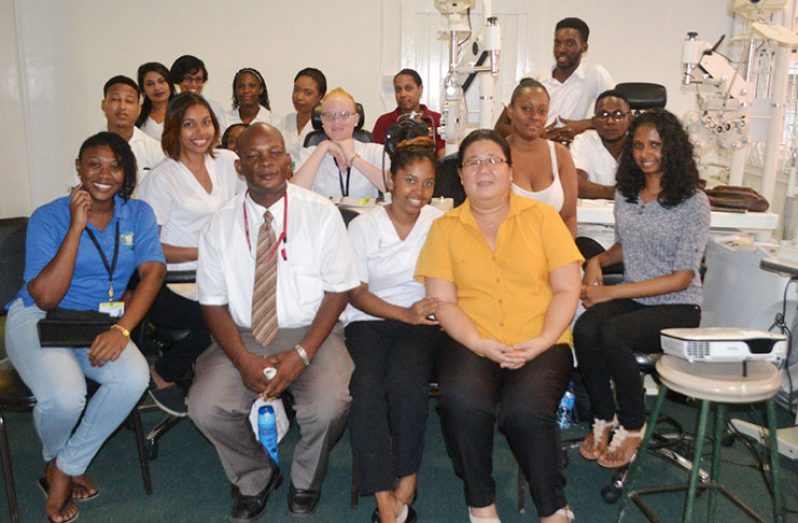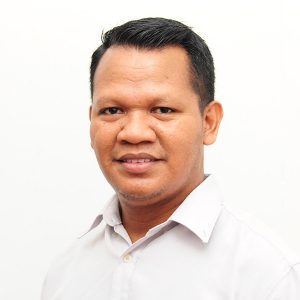OPTIMISM is at its peak at the University of Guyana (UG) because a team from the Caribbean Accreditation Authority for Education in Medicine and other Health Professions (CAAM-HP) is expected in Guyana this weekend to commence a re-accreditation assessment of the University of Guyana’s School of Medicine (UGMS).At the same time, Dean of the Faculty of Health Sciences, Dr. Emanuel Cummings, is foreseeing the wider accreditation of other health programmes offered by the university, as expansion plans — which include addition of a spanking new World Bank- funded modern faculty building costing US$6.9 — are being considered.
The building, which will accommodate approximately 350 students, is undergoing an Environmental Impact Assessment (EIA) by sister faculty, the Faculty of Earth and Environmental Science, which was contracted by the World Bank to undertake an assessment of the initiative.
A concrete pronouncement on the project is expected in March 2017, an optimistic Dr. Cummings told this publication at the Turkeyen Campus on Friday during an interview. He later toured the faculty as UG prepares for the CAAM-HP visit.
In 2015, the medical school’s provisional accreditation status was revoked by CAAM-HP, a move which prompted the nation’s leading tertiary institution to clinically review a series of recommendations which were provided to the university over the years following continuous assessments by the regional accreditation body.
This, along with non-submission of annual reports to the CAAM-HP, led to the revocation of the accreditation status.
Dr. Cummings explained that the UGMS received its provisional accreditation status in 2006, and in 2008 received full accreditation for the programme for a four-year period. In 2012 the status expired, but because of a hurricane that swept through the Caribbean at the time, CAAM-HP was unable to carry out its mandatory assessment that year.
However, the site team visited UG in 2013, and following evaluation of the medical programme, the status was downgraded to provisional accreditation.
Dr. Cummings said there were several deficiencies which resulted in the accreditation being lost in 2015.
ISSUES ADDRESSED
Following the blow to the university’s medical school, several issues were addressed. According to Dr. Cummings, the road to re-accreditation entailed the submission of a “self-study”, a process which constitutes the completion of several databases. These were completed and submitted in June this year.
Dr. Cummings explained that there are 144 standards which make up the databases, and areas assessed include the medical programme itself; the resources at hand; the teaching facilities at the faculty; internship, including the facilities where students operate at the Georgetown Public Hospital Corporation (GPHC), as well as the medical school’s relations to other branches of the wider university, including the personnel division and the bursary.
Among other shortcomings which are being corrected is the issue of part-time tutors. According to Dr. Cummings, a significant number of persons who teach at the school are part-time tutors. He said that recently, at the level of the Appointments Committee, the faculty was able to establish a new dispensation in which the part-time staffers will be grouped under what is termed an “Adjunct Faculty”.
He said this move places the school on par with what prevails at other universities across the globe, where there are assistant professors and full professors being under the employ of the university at the Faculty of Health Sciences.
Regarding this weekend’s visit, he said the five-member CAAM-HP team, which includes medical professionals from the University of the West Indies (UWI) and from as far away as Scotland, will arrive in Guyana on Saturday; and after they have met with him, Vice-Chancellor Dr. Ivelaw Griffith and other officials, the team will commence its assessment on Sunday at 15:00hrs.
In the process, the team would visit and hold a series of meetings on and off campus, and their tour would include interviews with students in order to obtain a feedback on the medical programme. The team concludes its work next Wednesday when it will provide a preliminary report on its findings.
Dr. Cummings is optimistic that the medical school will be re-accredited.
SIGNIFICANT PROGRESS
“Simply because, over the last two years, we have made significant progress; indeed, we have had some setbacks, however, we were able, with the support of several persons and entities, to prepare for the process ahead,” he said.
He listed those who have come to the aid of the medical school as: the Government of Guyana, which provided $30M to be used to purchase lab equipment; and the Pan American Health Organisation (PAHO), including PAHO/WHO Country Representative Dr. William Adu Krow, whom he noted had recommended a consultant who assisted in the preparation of the self-study.
He also noted that Professor Sara Stresser of the University of Ontario came to the aid of the medical school by assisting in the upgrade of the school’s curriculum — one of several issues which he noted had led to the accreditation being dropped last year.
“There are several others: Dr. Madam Rambarran, Dr. Hanoman of the GPHC; many others, including UG itself and the World Bank,” he added.
As regards the latter, Dr. Cummings noted that the international financial institution has been supportive of the school’s re-accreditation process.
He explained that the proposed new faculty building would provide added dimensions to the medical school and possible accreditation of other programmes, such as dentistry and pharmacy.
The dean explained that the plan on the ground includes construction of five laboratories, including labs for microbiology, clinical skills, anatomy and biochemistry.
In addition, eleven 50-seater classrooms, two 75-seater classrooms, a research library, a common room for students to relax, and a boardroom are planned for the new faculty building.
“So we will have that together along with our current faculty,” he said.
At the moment, plans for construction of the Yesu Persaud Clinical Facility at the GPHC are being fine-tuned, and Cabinet has appointed an oversight committee to manage the US$1M project, which is being financed by the Guyanese business magnate.
The building will house facilities for medical students, and will be situated next to the GPHC Maternity Ward. The site plan is being prepared for submission to the City Council for approval.



.jpg)











